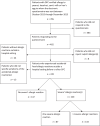Self-reported accidental allergic reactions among patients with challenge-verified food allergy
- PMID: 40533194
- PMCID: PMC12176468
- DOI: 10.1002/clt2.70067
Self-reported accidental allergic reactions among patients with challenge-verified food allergy
Abstract
Background: Food allergy affects up to 6% of the population and emergency department visits due to accidental food-allergic reactions are increasing. This study evaluated accidental allergic reactions outside the hospital and the number of hospitalizations in food allergic patients as well as the pattern before and after the diagnosis of food allergy by oral food challenge (OFC).
Methods: An electronic questionnaire concerning accidental allergic reactions was sent to 785 patients with challenge verified peanuts, hazelnuts, cow's milk and/or hen's egg allergies at the Allergy Centre, Odense University Hospital, Denmark.
Results: In total, 51% (402/785) responded. Among the 357 who reported at least one accidental allergic reaction, 51.5% (184/357) reported a total of six or less reactions, whereas 22.4% (80/357) had experienced a total of ≥21 reactions. Skin symptoms were commonly reported by children/adolescents (n = 277), whereas symptoms from all other organ systems were more frequently reported by adults (n = 80). In total, 61.6% (220/357) experienced at least one accidental allergic reaction, requiring immediate medical attention, which decreased from 77.3% (170/220) before to 55% (121/220) after establishment of the food allergy diagnosis by OFC. A concomitant proportional increase in the number of hospitalizations was identified (63.5% (108/170) to 72.7% (88/121)).
Limitations: We had no exact data on the timing of the accidental allergic reactions for the individual allergens.
Conclusion: Accidental food-allergic reactions are common and often severe. After the diagnostic OFC, the number of patients with reactions decreased, and the proportion of hospitalizations increased, indicating improved disease and healthcare management.
Keywords: accidental allergic reaction; allergic reactions; anaphylaxis; food allergy; oral food challenge.
© 2025 The Author(s). Clinical and Translational Allergy published by John Wiley and Sons Ltd on behalf of European Academy of Allergy and Clinical Immunology.
Conflict of interest statement
The authors declare no conflicts of interest.
Figures




Similar articles
-
Surveillance for Violent Deaths - National Violent Death Reporting System, 50 States, the District of Columbia, and Puerto Rico, 2022.MMWR Surveill Summ. 2025 Jun 12;74(5):1-42. doi: 10.15585/mmwr.ss7405a1. MMWR Surveill Summ. 2025. PMID: 40493548 Free PMC article.
-
The Basophil Activation Test Is the Most Accurate Test in Predicting Allergic Reactions to Baked and Fresh Cow's Milk During Oral Food Challenges.Allergy. 2025 Aug 13. doi: 10.1111/all.16675. Online ahead of print. Allergy. 2025. PMID: 40808324
-
Return to Running After Achilles Tendon Repair: How Do US Navy Service Members' Physical Readiness Tests Change After Undergoing an Achilles Tendon Repair?Clin Orthop Relat Res. 2025 Jun 18. doi: 10.1097/CORR.0000000000003590. Online ahead of print. Clin Orthop Relat Res. 2025. PMID: 40536551
-
Pharmacological and electronic cigarette interventions for smoking cessation in adults: component network meta-analyses.Cochrane Database Syst Rev. 2023 Sep 12;9(9):CD015226. doi: 10.1002/14651858.CD015226.pub2. Cochrane Database Syst Rev. 2023. PMID: 37696529 Free PMC article.
-
Prenatal administration of progestogens for preventing spontaneous preterm birth in women with a multiple pregnancy.Cochrane Database Syst Rev. 2019 Nov 20;2019(11):CD012024. doi: 10.1002/14651858.CD012024.pub3. Cochrane Database Syst Rev. 2019. PMID: 31745984 Free PMC article.
References
LinkOut - more resources
Full Text Sources

